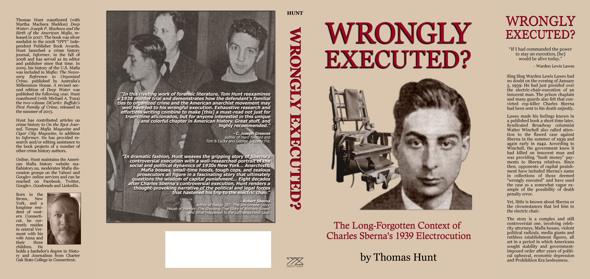UPDATE (Oct. 25, 2020): The first 1,045 pages (and 1,078 pages in all) are available online. There are just 122 pages of Valachi’s text left to digitize and format.
- Part 1 – Complete, 313 pgs, numbered 1 thru 299*.
- Part 2 – Complete, 307 pgs, numbered 300 thru 599*.
- Part 3 – Complete, 300 pgs, numbered 600 thru 899.
- Part 4 – 158 pgs, numbered 900 thru 1025, 1096 thru 1103, 1106 thru 1115, 1138 thru 1140, 1158 thru 1163, 1165 thru 1168, 1179, 1180.
UPDATE (Feb. 18, 2020): The total number of Valachi manuscript pages online has reached 888, including the first 826 consecutive pages. Visit The Real Thing section of the Mafiahistory.us website to see what is available.
UPDATE (Jan. 7, 2020): Dozens of new pages have been added to Part 3 of the Valachi manuscript The Real Thing. The total number of available document pages is now 761. That includes the first 687 consecutive pages.
- Part 1 – Complete, 313 pgs, numbered 1 thru 299*.
- Part 2 – Complete, 307 pgs, numbered 300 thru 599*.
- Part 3 – 108 pgs, numbered 600 thru 666, 670, 761, 762, 771, 772, 798 thru 801, 803 thru 805, 808, 809, 826 thru 830, 832 thru 853.
- Part 4 – 33 pgs, numbered 1096 thru 1103, 1106 thru 1115, 1138 thru 1140, 1158 thru 1163, 1165 thru 1168, 1179, 1180.
*Note: Some page numbers are used more than once, causing the page count to disagree with the page numbers.
UPDATE (Dec. 12, 2019): Part 2 of the Valachi manuscript The Real Thing is now available in its entirety. There are 307 pages, numbered 300 through 599 (with some numbers used more than once). Visitors may now read the first 621 consecutive pages of the manuscript. An additional 77 pages are available in scattered portions of Parts 3 and 4. The total number of pages now online is 698.
- Part 1 – Complete, 313 pgs, numbered 1 thru 299.
- Part 2 – Complete, 307 pgs, numbered 300 thru 599.
- Part 3 – 45 pgs.
- Part 4 – 33 pgs.
- Current overall – 698 pgs.
UPDATE (Dec. 5, 2019): Fifty-four pages have been added over the past ten days. These have all gone the second section of the Valachi manuscript, The Real Thing. That section now features a total of 247 pages, including the first 243 consecutive pages. With the first section already entirely in place, visitors can read through the first 556 pages of the memoirs (due to the insertion of information between already numbered pages, this includes from Page 1 through Page 535). An additional 77 pages are available in scattered portions of the third and fourth section, bringing the total number of pages now online to 637.
UPDATE (Nov. 25, 2019): Another fifty-six pages have been added to the second section of the Valachi manuscript, The Real Thing. Available page totals are shown here:
- Section 1 – Complete – 313 pages, numbered 1 through 299*
- Section 2 – 193 available, including the first 189 pages of the section (allowing visitors to read from numbered Page 1 through numbered Page 481 – a total of 502 consecutive pages*).
- Section 3 – 44 available.
- Section 4 – 33 available.
- Current overall total = 583 pages.
(* Valachi inserted some pages between previously numbered pages, so total page count does not match the assigned page numbers.)
UPDATE (Nov. 15, 2019): Twenty-two more pages were added to the second section of the Valachi manuscript, The Real Thing, bringing its total to 137 available pages (Visit: https://mafiahistory.us/a023/therealthing2.html ) The total number of online document pages – all four sections – has reached 527. Consecutive available pages run from Page 1 through Page 407. Due to oddities in the page numbering (some sheets were inserted between previously numbered pages), this actually includes a total of 428 consecutive pages of the manuscript.
UPDATE (Nov. 12, 2019): Twenty-two pages were added for the second section of the Valachi manuscript, The Real Thing, bringing its total to 115 available pages. (Visit: https://mafiahistory.us/a023/therealthing2.html ) The total number of online document pages – all four sections – has reached 505. The second section includes discussions of the Castellammarese War, Salvatore Maranzano and the post-Maranzano Mafia. There are nearly 400 consecutive available pages from the start of the document.
UPDATE (Nov. 9, 2019): With the addition of 65 more pages, the first section of the Valachi manuscript, The Real Thing, is now all set. (Visit: https://mafiahistory.us/a023/therealthing1.html ) The pages are numbered 1 through 299. However, some of the page numbers are duplicated. The actual total number of pages available in this section totals 313. In the section, Valachi describes his home life, friendships, his career as a burglar, time in prison and his early associations with Mafia organizations in East Harlem and the Bronx. The manuscript has been divided into four sections. The total number of pages – all sections – now available online is 483.
Nov. 8, 2019 – About 100 pages were recently added to the Joseph Valachi memoirs on the website, bringing the total pages to 418. It is our goal to make all pages of Valachi’s The Real Thing manuscript – the source material for a book entitled, The Valachi Papers – available to our web visitors.
The document, which runs well over one thousand pages in length, has been divided into four sections. We now have available 248 pages of the first section, 93 of the second section, 44 of the third section and 33 of the fourth section.
We have added an introductory “Contents” page with direct links to all available pages.




